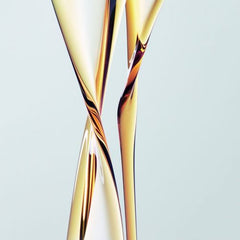
Like our own health, our hair can take a hit from time to time, so our guide to finding the best products for damaged hair will get your hair back on track. There are two types of damage that occur. The first is manageable and you can do something about; the second can be fatal for your hair.
Initially, your hair will suffer outer cuticle damage, which will eventually lead to the more serious and irreversible structural damage. Cuticle damage will ravage the outer platelet layers of your hair, which are hard and strong in healthy hair. These protect the inner structure, which is soft and weak. Once this cuticle layer fails, the inner structure will fail. Structural damage occurs when the disulphide bonds that form your hair have become too weak to retain their structure.
Signs that your hair is damaged
Damaged hair and breakage: Typically, when hair breaks, the ends of the snapped hair are blunt where it has fractured. If it is new hair growth, the end of the hair tends to tail off and become finer. If hair breakage has been an ongoing issue, you will notice breakage at different points throughout the hair which can make the hair appearance look frizzy and dull.
Damaged hair looks dull: Chemicals, heat and environmental aggressors such as UV light all affect the outer part of the hair cuticle, which is made up of layers of platelets. Healthy hair has tight platelets that lay flat and smooth, keeping moisture inside the hair. The flat smooth cuticles reflect light, which is why the hair looks shiny. Damaged hair, however, starts with a damaged cuticle layer, causing the hair to lose moisture and become dehydrated, porous and visibly dull.
Damaged hair and split-ends: If left untreated, a damaged cuticle layer will result in weakening of the hair and its internal bonds, resulting in structural damage and breakage. Your hair will feel coarse where the cuticle layers have been damaged and on the ends of the hair falls apart, resulting in 'split ends'.
Damaged hair feels coarse: When hair is dehydrated, it will be less supple and the outer cuticle becomes irregular and raised instead of smooth, making the hair feel dry and rough.
Why is my hair damaged?
The main four types of damage are: colour and chemical damage; heat and mechanical damage; environmental damage; and genetics and health factors.
Colour and chemical treatments such as permanent straightening and perming will alter the structure of your hair, making it more fragile and leaving it susceptible to damage. The colouring process opens the outer protective hair cuticles by raising them slightly so that colour molecules or bleaching agents can develop inside the hair shaft to create your desired hair colour. Similarly, chemical straightening and perming changes the bonds within the hair so that they reform to hold a different shape, giving you straighter or more curly hair. With repeated colouring or chemical treatments, the hair can become damaged.
Heat styling and mechanical handling will result in hair damage over time. When you heat your hair with styling tools, it softens the bonds in the hair, allowing you to change its appearance and shape, and over time this will take its toll on the outer structure. When the outer cuticle becomes damaged, it sheds and creates holes. The result is weaker hair that is more reactive to humidity and temperature changes, causing its texture to become frizzy and dry. Using a heat protector will reduce damage and also help your hair to retain its style so the cuticle will be less sensitised.
Environmental aggressors including hard water, exposure to sunlight and extreme temperature and weather changes, particular when coupled with a styling routine, will also take their toll on your hair. Mineral deposits from hard water form a build-up that makes hair look dull and feel stiff and lifeless. If you are prone to oily hair, the natural oil that would normally hydrate your hair cannot be absorbed due to the mineral build-up, resulting in further dryness. Use a shampoo for damaged hair that will gently remove impurities as well as repair your hair. Shu Uemura Ultimate Reset Shampoo is good at gently detoxing damaged hair to leave it soft and shiny. In addition, UV light breaks down hair proteins and melanins, ultimately resulting in more brittle, weaker hair. When in the sun for prolonged periods, cover your hair or use a UV hair protector such as Aveda’s Sun Care Protective Hair Veil, which will hydrate and protect.
Genetics and health will dictate your hair resilience, and your hair condition will often depend on how durable and hardwearing your natural hair structure is. When your body is under stress, it prioritises body functions and processes that are essential, cutting back on the non-essential functions like hair and nail growth. As a result, hair can become weaker and more easily damaged than normal. Similarly, if you have been trying to shed pounds quickly, such as through extreme dieting, your body again cuts back on non-essential body functions. To protect your hair, consider using a shampoo for damaged hair that will fortify and strengthen it, as well as consider taking a hair supplement that contains zinc, folic acid and iron to strengthen from the inside out.





